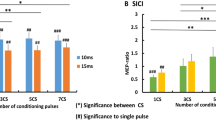Abstract
Since 1985, transcranial magnetic stimulation (TMS) has been widely used for the investigation of different processes in the human central nervous system. We studied the thresholds of the motor-evoked responses (MER) during TMS and their hemispheric differences in healthy subjects and patients with brain tumors of different localization: in the brainstem projection, left and right motor areas, and left frontal-temporal area. The obtained results testify to a lower threshold of MER in healthy subjects during TMS of the dominant hemisphere. In patients with brainstem tumors, there was a decrease in the thresholds of MER during TMS. In patients with tumors in the motor area, the thresholds of MER were increased on the lesion side, whereas in patients with tumors in the left temporal area, the thresholds were significantly decreased during TMS of the lesioned hemisphere.
Similar content being viewed by others
REFERENCES
Barker, A.T., Jalinouse, R., and Freestone, I.L., Noninvasive Magnetic Stimulation of the Human Motor Cortex, Lancet, 1985, vol. 1, p. 1106.
Gimranov, R.F., Application of Transcranial Magnetic Stimulation in Medicine, Vopr. Neirokhir., 1999, no. 3, p. 36.
George, M., Wassermann, E.M., Wendol, W.A., et al. Changes in Mood and Hormone Levels after Rapid-Rate Transcranial Magnetic Stimulation (rTMS) of the Prefrontal Cortex, J. Neuropsychiatry a. Clin. Neurosci., 1996, vol. 8., p. 172.
Hofman, R.E., Boutros, N.N., Hu, S., et al., Transcranial Magnetic Stimulation and Auditory Hallucinations in Schizophrenia, Lancet, 2000, v. 355, p. 1073.
Sicbner, H.R., Tormost, J.M., and Ceballos-Baumaon, A.O., Low-frequency rTMS of the Motor Cortex in Writers Cramp, Neurology, 1999, vol. 52, p. 529.
Walsh, V., Brain Mapping: Faradization of the Mind, Current Biol., 1998, vol. 8, p. R8.
Young, M.S., Triggs, W.J., Bowers, D., et al., Stereotactic Pallidotomy Lengthens the TMS Silent Period in Parkinson's Disease, Neurology, 1997, vol. 49, p. 1278.
Ravenborg, M., Blinkenberg, M., and Dahl, K., Standardization of Facilitation of Compound Muscle Action Potentials Evoked by Magnetic Stimulation of the Motor Cortex. Results in Healthy Volunteers and in Patients with Multiple Sclerosis, Electroencephalogr. Clin. Neurophysiol., 1991, vol. 81, p. 195.
Xing, J., Katayama, Y., Yamamoto, T., et al., Quantitative Evaluation of Hemiparesis with Corticomyographic Motor Evoked Potential by TMS, J. Neurotrauma, 1990, vol. 7, p. 57.
Reutens, D.C., and Berkovic, S.F. Increased Cortical Excitability in Generalized Epilepsy Demonstrated with Transcranial Magnetic Stimulation, Lancet, 1992, vol. 339, p. 362.
Reutens, D.C., Puce, A., and Berkovic, S.F., Cortical Hyperexcitability in Progressive Myoclonus Epilepsy: A Study with Transcranial Magnetic Stimulation, Neurology, 1993, vol 43, p. 186.
Macdonell, R.A.L., Shapiro, B.E., Chiappa, K.N., et al., Hemispheric Threshold Differences for Motor Evoked Potentials Produced by Magnetic Coil Stimulation, Neurology, 1991, vol. 41, p. 441.
Matsunga, K., Uozumi, T., Tsuji, S., and Murai, Y., Age-Dependent Changes in Physiological Threshold Asymmetries for the Motor Evoked Potential and Silent Period Following Transcranial Magnetic Stimulation, Electroencephalogr. Clin. Neurophysiol., 1998, vol. 109, p. 502.
Bragina, N.N. and Dobrokhotova, T.A., Funktsional'nye asimmetrii cheloveka (Functional Asymmetries of a Human), Moscow: Meditsina, 1988.
Triggs, W.J., Calvamo, R., Macdonell, R.A.L., et al., Physiological Motor Asymmetry in Human Handedness: Evidence from Transcranial Magnetic Stimulation, Brain Res., 1994, vol. 636, p. 270.
Schwarz, S., Hacke, W. and Schwab., S., Magnetic Evoked Potentials in Neurocritical Patient with Acute Brainstem Lesions, J. Neurol. Sci., 2000, vol. 172, p. 30.
Cramer, S.C. and Bastings, E.P., Mapping Clinically Relevant Plasticity after Stroke, Neuropharmacology, 2000, vol. 39, p. 842.
Roricht, S. and Meyer, B.U., Residual Function in Motor Cortex Contralateral to Amputated Hand, Neurology, 2000, vol. 54, p. 984.
Author information
Authors and Affiliations
Rights and permissions
About this article
Cite this article
Gimranov, R.F. Study of Thresholds of Motor Evoked Responses during Transcranial Magnetic Stimulation in Healthy Subjects and Patients with Brain Tumors. Human Physiology 28, 413–416 (2002). https://doi.org/10.1023/A:1016573713772
Issue Date:
DOI: https://doi.org/10.1023/A:1016573713772




